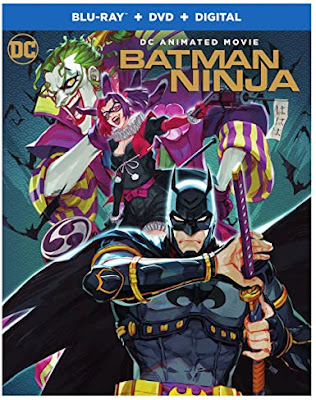PHENOMENALITY: *marvelous*
MYTHICITY: *poor*
FRYEAN MYTHOS: *adventure*
CAMPBELLIAN FUNCTION: *sociological*
In “The Ballad of East and West,” Rudyard Kipling averred
that East and West would never meet in any meaningful way, except in the situation
where “two strong men” of the opposed cultures took one another’s measure and
came to appreciate one another’s substance. In BATMAN NINJA we have a sort of meeting—or
maybe just a collision—between the Western pop-mythology of Batman comics and
the tropes of a specific Eastern culture, that of Japan. Given the way Japanese
pop culture has thoroughly imbricated that of the United States, this sounds
like this ought to be a good idea. It’s still a good idea, even if this is a
terrible execution.
The producers might have opted for an “Elseworlds” approach,
in which Batman and his support-cast might have been transformed into Japanese
avatars of their normal selves. Instead, they go the time-travel route. For no
sound reason, Gorilla Grodd—best known as a villain for the Flash more than for
Batman—decides to test a time-travel machine at Gotham’s famed booby hatch,
Arkham Asylum. By accident or design, Grodd gets flung back in time, along with
six Bat-villains: Joker, Harley Quinn, Penguin, Two-Face, Poison Ivy and
Deathstroke (the last also not a Bat-regular). Batman happens to be on the
scene with four, count ‘em four, of his Robin-brigade, and his butler Alfred
too. Oh, and Catwoman is also caught in the time-vortex, though it’s never
clear what she was doing at Arkham. All of them end up in medieval Japan, In
order that the script can make Batman the “odd man out” who gets everything
explained to him, the caped crusader materializes two years after everyone else
in the cast. Thus, all the other characters have established themselves in Nipponese
culture during the era of “the warring states,” when various feudal states were
in perpetual conflict for the goal of power.
Catwoman, clad in a not-very-Japanese version of her
costume, gets to explain to Bats how all seven villains have taken control of
assorted Japanese domains. The script glosses over how seven non-Asian criminals—one
of whom is a talking ape—managed to edge their way into the command of kingdoms
made up of a very homogenous people. In essence, the script merely recycles the
idea of crime-kingpins divvying up different quarters of some big city, with no
notion as to how such a concept would play out in a medieval Asian country.
Most of the super-crooks are content to fight amongst themselves, and to prepare
for the advent of the “Bat-ninja,” but Grodd has some sort of plan to get rid
of all humans and turn everything into a “medieval world of the apes.”
Though the wandering script cries out for more humor—maybe someone
could have sung, “I think I’m turning Japanese?”—at least Joker, unlike the
other fiends, more or less fits the mold of the autocratic feudal lord. Maybe
it helps that his clown-face may make one think of kabuki-actors. He gets all
the good lines and most of the fights, while the others are mopped up by
Catwoman and the Robin-brigade. The art-design is very florid and busy, but it
does give the viewer something to look at, given that the action scenes are
overly mannered. Batman transforms into a bat-ninja credibly enough, but the writer
should have confined the conflict to the hero and the Kabuki Prince of Crime,
since no one else comes off well. It’s merely annoying to have Alfred whip together
versions of the Batcave and the Batmobile for his master. But when the script decides
that it’s going to riff the “transforming giant robots” genre in this
non-technological era, this indicates that the writers had scant respect for
the basic idea. (The Japanese script differs in some minor ways from the American
dialogue, and since I watched the American dub with the Japanese subtitles, I
tend to think all the creators were equally meretricious.)
Grodd is defeated, the world is saved, and everyone goes
back to the 20th century. I’m rather surprised that the writers didn’t
work in any important Japanese characters, fictional or historical, to either
help or hinder Batman. There’s a cadre of ninjas who take Batman as their totem,
though none of them are developed individuals, and one of the Robins befriends
a pet monkey. Not exactly a stellar showing for the culture of Old Japan.

No comments:
Post a Comment